Physical Address
304 North Cardinal St.
Dorchester Center, MA 02124
Although patent foramen ovale (PFO) and atrial septal defect (ASD) both involve an abnormal communication across the interatrial septum, their causes are different. PFO results from lack of fusion between the septum primum and the septum secundum, whereas a secundum ASD is caused by the absence of a segment of the atrial septum.
PFO has been associated with paradoxical embolization, cryptogenic stroke, migraine headache, decompression sickness, and platypnea-orthodeoxia syndrome.
The role of PFO closure for recurrent ischemic cerebrovascular events is supported with recently published data, but remains controversial.
Elective closure of ASDs by 4 to 5 years of age is usually recommended, but if undetected until adulthood, indications for closure include right heart enlargement, paradoxical embolism, and platypnea-orthodeoxia syndrome.
Anatomic variations may require advanced closure techniques for successful closure, but in general, percutaneous closure of a PFO or a secundum ASD is a technically straightforward and safe procedure.
Atrial septal defects (ASDs) are some of the most common congenital cardiac anomalies. The first surgical repair of an ASD occurred in 1952. Nearly 25 years later, in 1976, King and Mills reported the first percutaneous ASD closure in five patients using a double-umbrella device. The early successes were followed by use of the Rashkind device and subsequently the Lock Clamshell Occluder in the late 1980s. Refinements in percutaneous interventional technology and advances in cardiac imaging techniques have largely swayed contemporary management of ASDs to the cardiac catheterization lab. Patent foramen ovale (PFO), which had been rarely treated surgically, despite its known association with paradoxical embolism, is also now considered for percutaneous closure.
This chapter describes the embryology, pathophysiology, and clinical associations of these anatomic defects, followed by a technical description of the procedure, its indications, complications, and the relevant data.
PFO is a remnant of the fetal circulation. By day 18 of gestation, the primordium of the heart becomes evident. At the end of the fourth week, the endocardial cushions fuse to form the right and left atrioventricular canals. The endocardial cushions serve as the primordium of the atrioventricular valves and the inferior wall of the atrium.
At this time, the common atrium undergoes a process of septation. The septum primum grows caudally toward the endocardial cushions, closing the interatrial communication (ostium primum) . As the septum primum reaches its destination, the cells in its superior portion undergo apoptosis and coalesce to form the ostium secundum. A muscular septum secundum forms to the right of the septum primum and extends to reach the caudal border of the ostium secundum, forming a flaplike valve between both atria ( Fig. 49.1 and ![]() ).
).
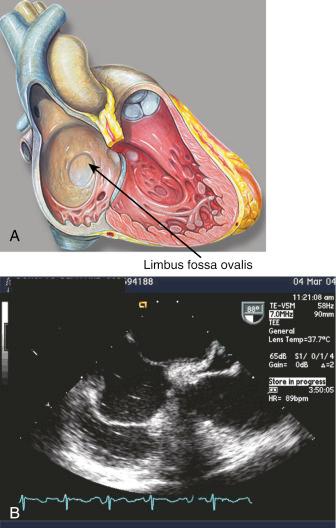
Oxygenated placental blood enters the right atrium from the inferior vena cava (IVC) and is directed toward the interatrial septum (IAS) by the eustachian valve. The low left atrial pressure, the lack of blood flow through the pulmonary veins, and the preferential flow of the IVC to the IAS allow oxygenated blood to cross the foramen ovale and enter the systemic circulation. Blood entering the right atrium from the superior vena cava (SVC) is directed away from the IAS by the crista interveniens , preventing the mixture of nonoxygenated blood in this chamber. The right horn of the sinus venosus incorporates the SVC and IVC into the right atrium ( ![]() ).
).
At birth, the pulmonary vascular resistances and the right cardiac pressures fall, and the left atrial pressure increases, forcing the septum primum against the septum secundum and occluding the valvelike foramen ovale. Complete occlusion occurs in most of the population, but in approximately 25%, the fusion is incomplete, giving rise to a PFO ( ![]() ).
).
The echocardiographic estimate for the incidence of PFO in the adult population is approximately 25%. Autopsy studies revealed probe-patent PFOs of 0.2 to 0.5 cm in 29%. The frequency of PFO decreases with age, but the size of the defect increases with each decade of life. The incidence rate of PFO is equal for both genders and among all ethnic groups; however, PFOs in whites and Hispanics are more prevalent and are associated with a greater degree of shunting. Spontaneous PFO closure may occur during adulthood, although data suggest that PFOs may recanalize over time.
PFO was thought to be an inconsequential finding until 1877, when Cohnheim postulated that a venous thrombosis might paradoxically traverse a foramen ovale and produce a systemic embolism. Since then, PFOs have been associated with various disease processes, including cryptogenic stroke, paradoxical embolization, platypnea orthodeoxia syndrome, hypoxemia with normal pulmonary pressures, decompression sickness (DCS) in scuba divers and high-altitude pilots, and migraine headaches.
The cause of cerebrovascular accidents (CVAs) varies among age groups. Atrial fibrillation and small vessel disease contribute to most strokes in patients older than 50 years. Among patients younger than 35 years, the most common causes include nonatherosclerotic arteriopathies, arterial dissection, and thromboembolism. However, in 35% to 40% of patients with CVAs, the causes remain unknown, even after a thorough evaluation. Such CVAs are classified as cryptogenic and are largely a diagnosis of exclusion.
Evaluation includes: a hypercoagulable evaluation, heart rhythm evaluation, and carotid doppler ( Table 49.1 ). In the 2018 updated American Heart Association/American Stroke Association (AHA/ASA) guidelines, routine use of echocardiography in all patients presenting with acute ischemic stroke to plan subsequent secondary preventive treatment is deemed not cost-effective and is not recommended (class III; Level of Evidence [LOE] B-NR).
| Condition | Diagnostic Test |
|---|---|
| Cerebrovascular disease | Carotid Doppler, magnetic resonance angiography |
| Cardiac source of embolism (in specific patient populations as per the updated 2018 AHA/ASA Guidelines) | |
| Left atrial appendage thrombus | Transesophageal echocardiogram |
| Left ventricular aneurysm | Transthoracic or transesophageal echocardiogram |
| Ascending aorta atheroma | Transesophageal echocardiogram |
| Paroxysmal atrial fibrillation | Holter monitor |
| Hypercoagulable state | Protein C and S activity Antithrombin III level Lupus anticoagulant Anticardiolipin antibody Factor V Leiden Prothrombin 20210A mutation |
The search for the probable causes of cryptogenic strokes has implicated PFOs. In a retrospective case-control study, PFOs were four times more prevalent among young adults who experienced a stroke without an identifiable cause compared with others with known causes. In a prospective trial of 503 patients, Handke and colleagues showed that PFOs were more frequent among patients experiencing cryptogenic strokes irrespective of age (<55 years: 43.9% vs. 14.3%, odds ratio [OR] = 4.70, P < .001; >55 years: 28.3% vs. 11.9%, OR = 2.92, P < .001). More recently, preoperative PFO was found to be significantly associated with increased risk of perioperative ischemic stroke within 30 days of noncardiac surgery (Ng et al.). Among patients with cryptogenic strokes, patients with PFOs were less likely to have traditional cardiovascular risk factors such as hypertension, hypercholesterolemia, and tobacco use.
Proposed mechanisms for PFO-associated cryptogenic strokes include in situ thrombosis, paradoxical embolization, and predisposition to atrial arrhythmias. Paradoxical embolization (i.e., passage of a venous thrombus into the systemic circulation through a PFO) has been the predominant theory ( Fig. 49.2 and ![]() ). Evidence that supports the role of PFOs in cryptogenic strokes includes case reports of the transit of thrombi across PFOs, cerebral distribution of cryptogenic CVAs that suggests an embolic nature, and the increased frequency of deep venous thrombosis in patients who had cryptogenic CVAs.
). Evidence that supports the role of PFOs in cryptogenic strokes includes case reports of the transit of thrombi across PFOs, cerebral distribution of cryptogenic CVAs that suggests an embolic nature, and the increased frequency of deep venous thrombosis in patients who had cryptogenic CVAs.
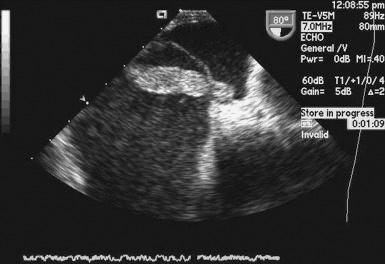
The Paradoxical Embolism from Large Veins in Ischemic Stroke (PELVIS) trial found an increased frequency of positive magnetic resonance venography testing for pelvic thrombus in patients with PFOs and cryptogenic CVAs compared with patients with known causes (20% vs. 4%, P < .03).
These data underline the causative role of paradoxical embolization in patients who had cryptogenic strokes.
The reported recurrence rate of cryptogenic stroke varies from 1.2% to more than 16%, but usually is about 2%. Retrospective studies have found the risk of recurrence to be related to PFO size, patency at rest, shunt severity, and the presence of atrial septal aneurysm (ASA). A prominent eustachian valve has been associated with increased patency of the foramen ovale and the risk of stroke recurrence because it preferentially directs blood flow to the IAS ( Fig. 49.3 and ![]() ). It has been postulated that a mobile IAS may increase the size of the foramen ovale, facilitating the passage of thrombi. Recurrences of cryptogenic CVAs have been associated with the degree of septal protrusion. Patients with a septum excursion greater than 6.5 mm had a risk of recurrence of 12.3% compared with 4.3% for controls at 3 years. Finally, the combination of ASA and PFO was associated with an increased risk of recurrence in a French PFO/ASA study (hazard ratio [HR] = 4.17; 95% confidence interval [CI] 1.47 to 11.84).
). It has been postulated that a mobile IAS may increase the size of the foramen ovale, facilitating the passage of thrombi. Recurrences of cryptogenic CVAs have been associated with the degree of septal protrusion. Patients with a septum excursion greater than 6.5 mm had a risk of recurrence of 12.3% compared with 4.3% for controls at 3 years. Finally, the combination of ASA and PFO was associated with an increased risk of recurrence in a French PFO/ASA study (hazard ratio [HR] = 4.17; 95% confidence interval [CI] 1.47 to 11.84).
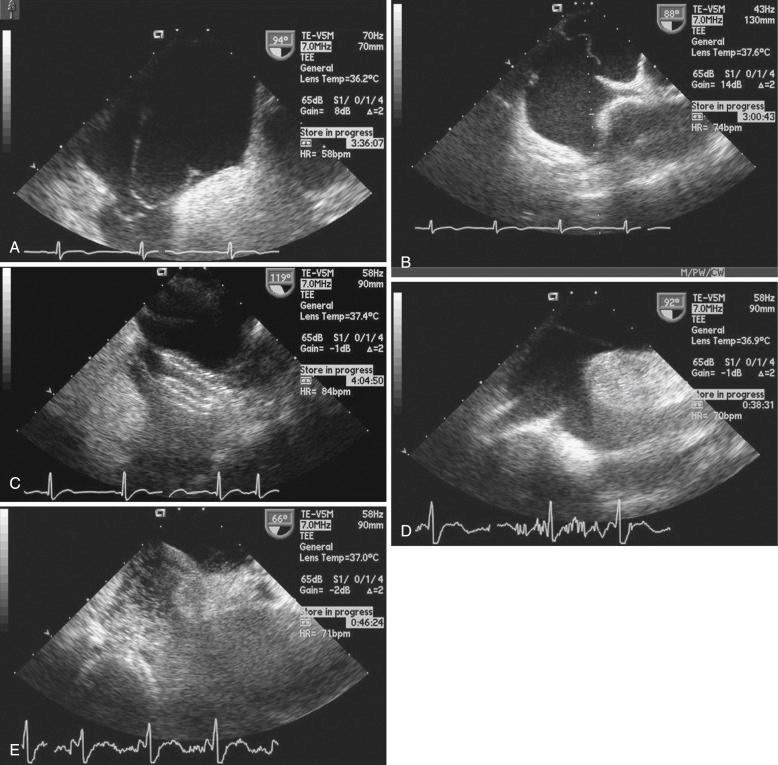
An index to assess the statistical attributability of cryptogenic stroke to PFO has been developed (RoPE Score), with emerging work correlating severity of right to left shunting by contrast transcranial doppler ( Table 49.2 ).
| Characteristic | Points | RoPE score |
|---|---|---|
| No history of hypertension | 1 | |
| No history of diabetes | 1 | |
| No history of stroke or TIA | 1 | |
| Nonsmoker | 1 | |
| Cortical infarct on imaging | 1 | |
| Age, years | ||
| 18–29 | 5 | |
| 30–39 | 4 | |
| 40–49 | 3 | |
| 50–59 | 2 | |
| 60–69 | 1 | |
| ≥70 | 0 | |
| Total score (sum of individual points) | ||
| Maximum score (a patient <30 years with no hypertension, no diabetes, no history of stroke or TIA, nonsmoker, and cortical infarct) | 10 | |
| Minimum score (a patient ≥70 years with hypertension, diabetes, prior stroke, current smoker, and no cortical infarct) | 0 |
Medical treatment with aspirin or oral anticoagulants has traditionally been utilized with mixed results on efficacy against recurrent neurologic events. In the French PFO/ASA study, 267 patients who experienced cryptogenic strokes and had PFOs only or PFOs with ASAs were treated with aspirin or with aspirin and warfarin if they had a venous thrombosis. After 4 years of follow-up, there were 12 episodes of recurrent strokes and 9 recurrent transient ischemic attacks (TIAs). All episodes occurred in patients treated with aspirin alone.
The PFO in Cryptogenic Stroke Study (PICSS) was the only prospective, blinded, randomized trial that compared the efficacy of aspirin versus oral anticoagulation in patients with CVAs. It found no statistically significant difference in stroke recurrence between patients with PFOs treated with aspirin and those treated with warfarin (17.9% vs. 9.5%; HR = 0.52; 95% CI 0.16 to 1.67; P = .28). Furthermore, the incidence of recurrent stroke in PFO patients with ischemic stroke was high: 14.8% at 2 years.
The 2014 AHA/ASA guidelines state that for patients with an ischemic stroke or TIA and a PFO who are not undergoing anticoagulation therapy, antiplatelet therapy is recommended (class I; LOE B). For patients with an ischemic stroke or TIA and both a PFO and a venous source of embolism, anticoagulation is indicated, depending on stroke characteristics (class I; LOE A). When anticoagulation is contraindicated, an IVC filter is reasonable (class IIa; LOE C). The updated 2018 AHA/ASA guidelines do not suggest superiority of either antiplatelet or anticoagulation management in cryptogenic stroke in PFO patients.
Surgical closure of PFOs in patients who had cryptogenic strokes has been reported. The largest series included 91 consecutive patients with a mean age of 44 years and one prior CVA. Surgery was evaluated with intraoperative transesophageal echocardiography (TEE), and suture or patch closure was employed. Closure was achieved in 98% of cases, and the actuarial freedom from recurrence was 93% at 1 year and 83% at 4 years. The surgical procedure was associated with significant morbidity in 21%. Smaller series reflected similar closure rates and significant morbidity.
Despite medical therapy, the stroke recurrence rate in ischemic stroke patients with PFO is estimated at 4.5% within a 4-year period. Thus secondary preventive treatment, such as percutaneous closure, in addition to medical therapy has been a topic of debate. Prior to 2017, three multicenter, randomized, controlled trials (RCTs) comparing PFO closure for recurrent cryptogenic stroke with medical therapy (CLOSURE I, PC, and RESPECT) had largely negative results, showing no statistically significant benefit of PFO closure over medical therapy for ischemic stroke recurrence. In addition, there was a significantly higher incidence of atrial fibrillation development in the patients who received the STARFlex closure device ( Fig. 49.4 ), but not the AMPLATZER PFO Occluder, compared with medication.
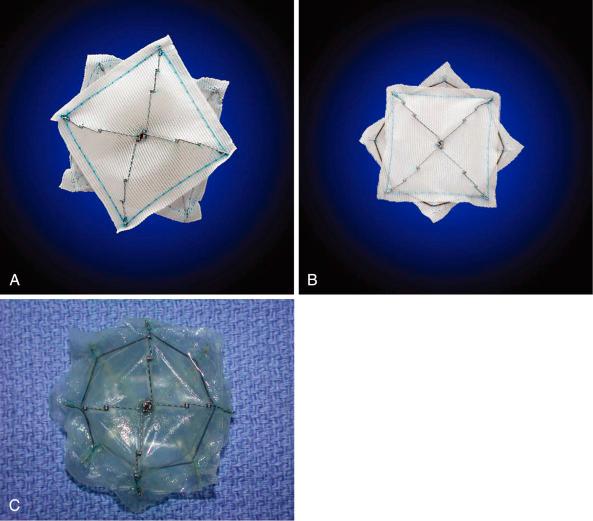
Based on these three RCTs, the 2014 AHA/ASA guidelines did not recommend PFO closure in cryptogenic stroke (class III, LOE A). However, in the setting of PFO and deep vein thrombosis (DVT), PFO closure by a transcatheter device might be considered, depending on the risk of recurrent DVT (class IIb; LOE C). The American Academy of Neurology discouraged routine PFO closure in cryptogenic stroke patients outside of research trials until July 2016, when an updated statement was issued criticizing its use altogether. However, in September 2017, three trials with positive results were published ( Fig. 49.5 ).
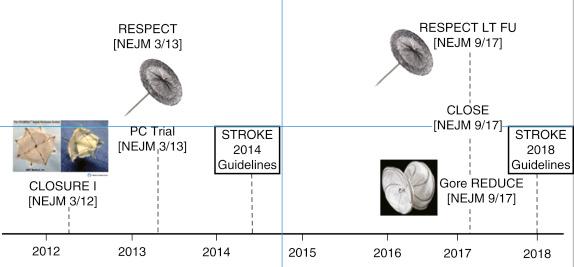
CLOSURE 1 (evaluation of the STARFlex septal closure system in patients with a stroke or TIA due to presumed paroxysmal embolism through the PFO) evaluated PFO closure with the CardioSeal and STARFlex septal occluders (see Fig. 49.4 ) compared with aspirin or warfarin, or both, in 909 patients 18 to 60 years old with a cryptogenic CVA or TIA during the 6 months before enrollment. Over a 2-year follow-up, the composite end point of CVA or TIA, all-cause death at 30 days, and death from neurologic causes between 31 and 730 days was similar among groups: 5.5% versus 6.8% for closure compared with antiplatelet or anticoagulant therapy (HR = 0.78; 95% CI 0.45 to 1.35; P = .37).
The PC trial (Patent Foramen Ovale and Cryptogenic Embolism) compared PFO closure using the Amplatzer PFO occluder with medical therapy (i.e., at least one antiplatelet or anticoagulant drug) in 414 patients aged younger than 60 years with a history of cryptogenic stroke, TIA, or peripheral embolism and documented PFO. The composite end point of death, nonfatal stroke, TIA, or peripheral embolism was similar for the groups (3.4% vs. 5.2%; HR = 0.63; 95% CI 0.24 to 1.62; P = .34).
The RESPECT trial (Randomized Evaluation of Recurrent Stroke Comparing PFO Closure to Established Standard of Care Treatment) compared PFO closure using the Amplatzer PFO occluder with antiplatelet or anticoagulation therapy (i.e., aspirin, warfarin, clopidogrel, aspirin plus dipyridamole, or aspirin plus clopidogrel) in 980 patients followed over a mean of 2.6 years. Although the primary end point was negative by intention-to-treat analysis (recurrent CVA for closure: 1.8% vs. 3.4% for antiplatelet/anticoagulant therapy; HR = 0.49; 95% CI 0.22 to 1.11; P = .08), three patients randomized to device closure had a stroke before receiving the device. The as-treated cohort analysis showed a positive trend favoring the device closure cohort (1.1% vs. 3.3%; HR = 0.27; 95% CI 0.10 to 0.75; P = .007), and the per-protocol cohort analysis favored transcatheter closure (1.3% vs. 3%; HR = 0.37; 95% CI 0.14 to 0.96; P = .03). The subset analysis favored device closure for PFO with associated ASAs.
The final long-term results of RESPECT showed that after 10 years, in an intention-to-treat analysis, PFO closure with the AMPLATZER PFO Occluder resulted in a 62% relative risk reduction (RRR) for recurrent ischemic stroke compared with medical management (HR 0.38; 95% CI 0.18 to 0.79; 10-year event rates 2.3% vs. 11.1 %; P = .007). The rates of atrial fibrillation, major bleeding, and death from any cause were comparable or lower in the device study arm.
The GORE HELEX Septal Occlulder/GORE CARDIOFORM Septal Occluder for PFO Closure in Stroke Patients (REDUCE) trial demonstrated that through at least 2 years, PFO closure with the GORE HELEX or GORE CARDIOFORM (both W.L. Gore & Associates) septal occluder plus antiplatelet therapy was superior to antiplatelet treatment alone in reducing the risk of recurrent (77% RRR; HR 0.23; 95% CI 0.09 to 0.62) and new clinical ischemic stroke or in silent brain infarct on MRI (49% RRR; HR 0.51; 95% CI 0.29 to 0.91).
The Patent Foramen Ovale Closure or Anticoagulants Versus Antiplatelet Therapy to Prevent Stroke Recurrence (CLOSE) study was a multicenter randomized superiority trial, comparing transcatheter PFO closure plus antiplatelet therapy to antiplatelet therapy alone for the prevention of recurrent stroke in patients aged 16 to 60 years who had a recent cryptogenic ischemic stroke attributed to PFO with an associated ASA or large right-to-left shunt. Recurrent fatal or nonfatal stroke was significantly reduced in the PFO closure group as compared with the antiplatelet therapy alone group (97% RR; HR 0.03; 95% CI 0.00 to 0.26; P < .001).
In both REDUCE and CLOSE, a higher incidence of atrial fibrillation was detected, but this was largely periprocedural and transient. The 2018 American College of Cardiology (ACC)/AHA Guidelines do not clearly support or disprove transcatheter closure, citing potential biases for the recent data.
PFO is present in up to 60% of migraine patients, and up to 50% of patients with PFO suffer from migraines. Retrospective analysis of patients who underwent PFO closure for cryptogenic strokes revealed a decrease in the frequency of attacks of migraine with aura in 80% or even complete resolution in 56%. Other studies have demonstrated that after a 12-month follow-up, the frequency and intensity of the migraine attacks were significantly decreased in patients who underwent PFO closure. These observational studies, however, are largely masked by three randomized controlled trials that do not suggest PFO closure for migraines is warranted.
The Migraine Intervention with STARFlex Technology (MIST) trial tested the association between PFOs and migraine headaches with aura. It was a multicenter, blinded study that randomized 432 patients with migraine to PFO closure with a STARFlex Septal Repair (NMT Medical, Boston, MA) implant or a sham procedure. The primary end point of cessation of migraines was not met. However, reduction in headache days in at least 50% occurred more frequently in the PFO closure group (42% vs. 23%, P = .038). The MIST II trial (evaluated PFO closure to treat migraine with aura; sponsored by NMT Medical, Boston, MA) and the ESCAPE trial (Effect of Septal Closure of Atrial PFO on Events of Migraine with the PFO Occlusion Device [ Fig. 49.6 ]; sponsored by St. Jude Medical Corp., Fullerton, CA) have been discontinued because of slow enrollment. The Percutaneous Closure of Patent Foramen Ovale in Patients with Migraine (PREMIUM) trial (evaluating use of the Amplatzer PFO occluder; sponsored by AGA Medical, Golden Valley, MN) also demonstrated negative results with no difference in responder rate, defined by reduction in migraine attacks. Based on these data, PFO closure for primary prevention of migraines is not recommended.
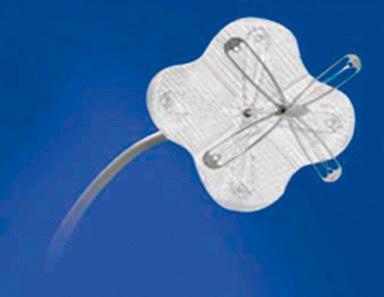
PFO has been associated with the rare platypnea-orthodeoxia syndrome. It is postulated that right-to-left shunting occurs across a patent foramen, particularly in the setting of an ASA.
Platypnea-orthodeoxia syndrome is seen primarily in very old patients and is associated with an event that alters the geometry of intrathoracic organs, such as a pneumonectomy or an enlarged ascending aorta. Extrinsic compression of the right atrium or decreased compliance of the right ventricle may also predispose to shunting at the atrial level in these patients. It is postulated that in patients with an elongated aorta, the heart is shifted laterally so that the IVC drains directly toward the atrial septum, although this is not fully understood. This anatomic shift maintains the PFO open throughout the cardiac cycle and generates the physical findings.
The diagnosis of platypnea-orthodeoxia syndrome is made by using saline contrast echocardiography with the patient in the supine and seated positions. Surgical or percutaneous closure has been done successfully, leading to marked improvement in the patient’s symptoms. The 2008 ACC/AHA guidelines for the management of adults with congenital heart disease have a class IIa, LOE B indication for reasonable closure of an atrial septal defect, either percutaneously or surgically, in the presence of documented platypnea-orthodeoxia.
Hypoxia related to PFOs may be observed in patients with severe pulmonary hypertension or obstructive sleep apnea. The mechanism involves transient or persistent elevation of the right atrial pressure in relation to the left atrial pressure or redirection of the IVC blood flow toward the IAS. Hypoxia related to right-to-left shunting at the atrial level has been associated with pulmonary arteriovenous malformations, liver disease, amiodarone toxicity, pulmonary emboli with transient pulmonary hypertension, positive-pressure ventilation, hypovolemia, aortic aneurysm, right ventricular infarction, Ebstein anomaly, and carcinoid valve disease.
Making the diagnosis may be challenging because it requires documentation of right-to-left shunting while the patient is hypoxic, and frank improvement occurs after closure. In patients with severe pulmonary hypertension with decreased right ventricular function, the PFO serves as an escape valve, which aids emptying of the right atrium into a lower pressure circuit (i.e., left atrium). In these patients, PFO closure may be fatal.
DCS is caused by nitrogen bubbles that come out of solution in blood as the ambient pressure decreases when a person ascends from a dive. The amount of nitrogen bubbles generated depends on the total time spent in the dive, the speed of ascent, compliance with decompression stops, and individual factors such as cardiac output. The nitrogen bubbles usually stay in the venous circulation and make it to the lungs, where they are rapidly diffused. In a person with a PFO, the nitrogen bubbles may enter the systemic circulation and travel superiorly toward the brain, occluding a small arterial branch.
DCS in patients with PFOs is associated with early onset of cerebral or vestibular symptoms, which occurs within 30 minutes after a dive, even after the person has performed all the appropriate rest stops. Accordingly, professional divers or military personnel may undergo screening for PFO with a bubble contrast transthoracic echocardiography (TTE) or TEE study. The presence of a PFO is considered a contraindication to diving. PFO closure is not recommended in this scenario. Recreational scuba divers may choose to undergo screening for the presence of a PFO at their own discretion.
Echocardiography plays an important role in the diagnosis of abnormalities of the atrial septum. Traditionally, TEE has been considered the gold standard to diagnose a PFO. The advantage of TEE is that it can identify all portions of the IAS, enabling the diagnosis of all subtypes of ASDs, fenestrated atrial septum, and PFOs. TEE also allows detailed identification of lipomatous hypertrophy of the septum, ASAs, a prominent eustachian valve, or a long PFO tunnel that may alter a planned closing procedure ( ![]() ; see Fig. 49.3 ).
; see Fig. 49.3 ).
TEE can identify other potential sources of embolization (e.g., left atrial appendage thrombus, cardiac tumors, aortic atheroma). An ASA is defined as a redundancy of the atrial septum with excursion greater than 10 mm into either of the atria and a 15-mm base. The degree and direction of the interatrial shunt depend on the net pressure difference between the atria. The interatrial shunt direction changes with the phase of respiration and the cardiac cycle. It can be documented by color Doppler interrogation of the IAS ( Fig. 49.7 ). Color interrogation along the fossa ovalis may cause erroneous identification of a PFO because of color cross-contamination when lowering the Nyquist limit.
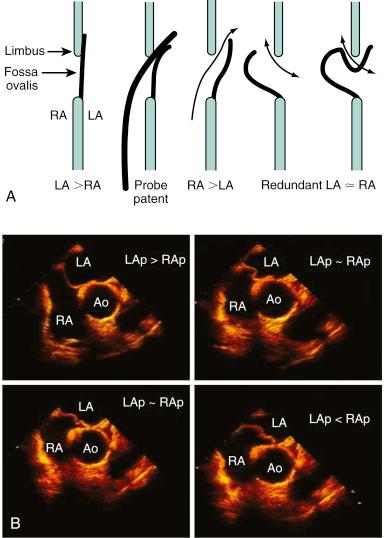
TEE’s diagnostic sensitivity is significantly lower than that of a saline contrast study; the addition of saline contrast improves TEE’s diagnostic sensitivity. The injection of saline contrast through the femoral vein is superior for the diagnosis of PFOs by TEE and for the appropriate sizing of ASDs. Appropriate provocative measures that transiently increase the right atrial pressure (i.e., Valsalva maneuver) may be difficult to perform during a TEE because of the patient’s sedation, relative hypovolemia from a fasting state, and the inability to close the glottis against the echo probe ( Figs. 49.8 and Figs. 49.9 and ![]() , ).
, ).

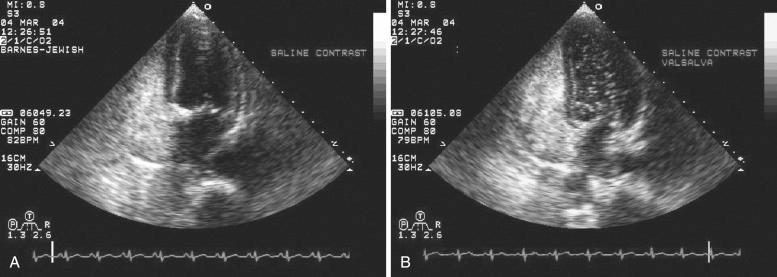
Fundamental imaging TTE has been considered inferior for the diagnosis of PFOs. However, the advent of second harmonic imaging has improved the sensitivity of TTE to 90%. An easier and more effective performance of a provocative maneuver (e.g., no sedation, euvolemia, complete glottic closure) during TTE may improve the image quality and is associated with a higher sensitivity than that of TEE for the diagnosis of PFOs.
The Amplatzer patent foramen ovale occlude (APO) is a self-expanding, double-disk device made from 0.005-inch nitinol wire (i.e., nickel-titanium alloy), with a polyester fabric sewn into both disks ( Fig. 49.10 ). The device has radiopaque marker bands and comes in 18 mm, 25 mm, and 35 mm sizes, and is recapturable and repositionable.
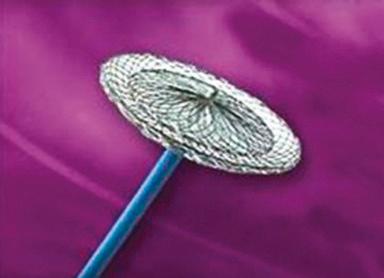
Device size represents the right atrial disk diameter. The right atrial disk stabilizes the device, preventing embolization from right to left. The thin stem allows various degrees of disk mobility that permit the PFO occluder to seat appropriately in a long tunnel or around a hypertrophied septum. The left atrial disk dimensions are designed to decrease interference with pulmonary venous drainage or with the mitral valve and to minimize the thrombogenic material in the systemic circulation.
Device sizing depends upon the measurement from the foramen ovale to the SVC and from the foramen ovale to the aorta. The right disk radius should not exceed the shortest distance obtained, unless there is an ASA in which case a larger occlude should be utilized to cover the aneurysm ( Table 49.3 ). The 25-mm device is used in most cases. The APO has the advantage of being self-expanding, has a simple deployment, and is placed through a small venous sheath (8 Fr for 18 mm and 25 m sizes and 9 Fr for the 35-mm size). It is fully retractable until it is released. In October 2016, the U.S. Food and Drug Administration (FDA) approved the APO occluder for reduction of recurrent ischemic stroke risk in patients who had a cryptogenic stoke presumed secondary to a paradoxical embolism, as determined by a neurologist and cardiologist.
| Distance From Defect to Superior Vena Cava or Aorta | Suggested Device Size | Delivery Sheath Size |
|---|---|---|
| >17.5 mm | 35 mm | 9 Fr |
| 12.5–17.4 mm | 25 mm | 8 Fr |
| 9–12.4 mm | 18 mm | 8 Fr |
| <9 mm | None |
Become a Clinical Tree membership for Full access and enjoy Unlimited articles
If you are a member. Log in here